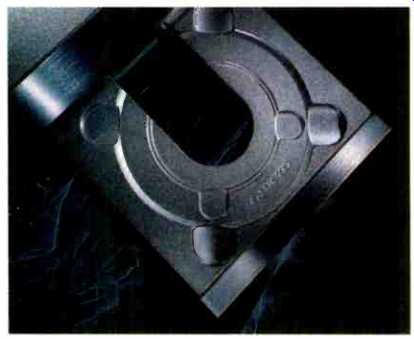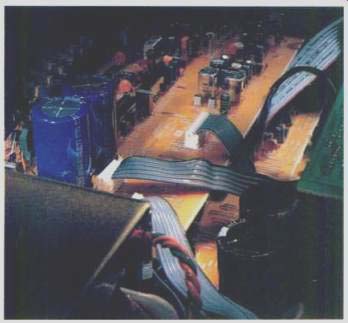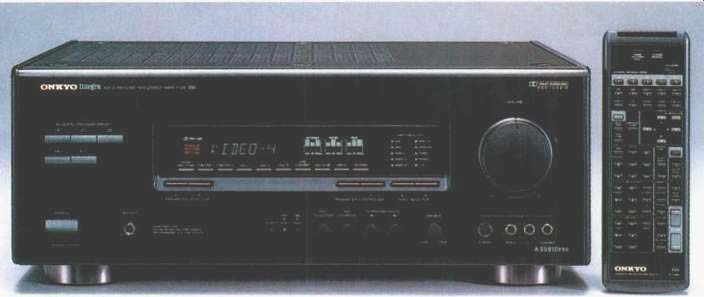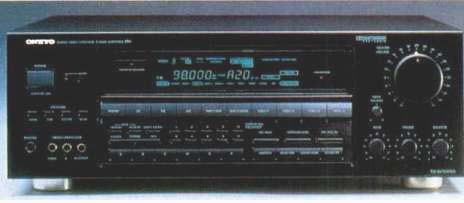The inside story on what really makes a great audio component.

Technology without quality is meaningless.
"It would be very easy for our engineers to add a lot of flashing lights and dials to our equipment but 'bells and whistles' are not what we're all about," Ted Green said.
Mr. Green, Onkyo's National Sales and Marketing Manager, is on the firing line in the battle to design electronics equipment for today's critical, value-oriented enthusiasts. And because Onkyo is an engineering-driven firm, their emphasis is on quality and substance, not glitz and glamour.
"Consumers can quickly hear, see and feel the difference between Onkyo equipment and the competition," Mr. Green added.
"Look at the front and you won't be overwhelmed by LEDs or buttons. Our components are made to be used easily. Lift an Onkyo receiver and you'll immediately notice the increased weight from the metal chassis, heavy duty transformer and heat sink.
And Onkyo has always featured the most up-to-date technology," Mr. Green stated. "Throughout the design, engineering and manufacturing process, our objective is to deliver the finest quality at a better feature per dollar ratio than any other components on the market."

above: Metal chassis, metal faceplates, even metal transports in the CD players
add up to structural integrity throughout the entire Onkyo line.

above: Heat sinks sound as if they belong in a high tech kitchen, but
Onkyo's heavy duty versions prevent thermal overload when you've pumped up
the volume.
ONKYO... Built to be Better
Quality is a word used by companies in many different industries. But what does it really mean to someone buying new hi-fi components? If you love music, it's the ability to experience the full dynamic range of a compact disc or cassette. Or drive a pair of sophisticated speakers to their utmost potential. Or hear the dramatic impact of a movie soundtrack on a Dolby Pro Logic system. All of the buzzwords and acronyms mean nothing, unless there is a proven real-world result that you can hear and appreciate, not simply a fancy decal on a faceplate, or slick slogan in an ad.
Onkyo's mandate couldn't be more clear. Onkyo will never make sacrifices or take shortcuts that impact upon the music you'll enjoy in your home. Whether it's a CD player, receiver, cassette deck or other component, if it bears the Onkyo name, you can be sure the quality was designed and built in, starting right at the drawing board. Onkyo's demanding engineers oversee every step of manufacture so the end results are award-winning products that perform well and, just as importantly, are a lasting value... from the least expensive models to the top-of-the-line. In fact, the long-term reliability of all Onkyo components--when compared to the competition--is far superior.
What makes Onkyo better? Here are some reasons why... Many hi-fi companies will use plastic parts in critical areas to keep down your initial cost. The price may be attractive at first but you'll lose the structural integrity of Onkyo's metal chassis or the accuracy of their die-cast aluminum CD tray... deficiencies that will unquestionably affect the sound heard in your home. The next time you're in a store, check out the vast number of components that utilize plastic or some other synthetic in their faceplates and chassis. Then examine Onkyo. It's easy to see why Onkyo sounds well made.
Power Plays
One of the most important functions of any receiver or amplifier is the ability to provide sufficient power during key musical moments.
It's really simple: the larger, more powerful the transformer, the more critical current is supplied. Without proper power, you won't be able to drive loudspeaker systems or components to their peak ability. A shortcut here severely impacts upon music quality. Onkyo's heavy duty power supplies are renowned for their ability to handle the most demanding and complex musical passages, which is why you'll find all our amps and receivers rated into 4 ohms (and in some cases even 2 ohms), the ultimate test of a power supply. And although a transformer may not have as much sex appeal as a flashy display, it's infinitely more vital to the bottom line--performance--which is why you buy a component in the first place.
Consequently, Onkyo engineers are always in the forefront of technical advances in component power. One of these is the breakthrough Anti Electromagnetic Interference (AEI) transformer that produces even lower distortion levels and more power than toroidal transformers found in high end, high priced separates.
Independent Thinking
Dedicating power supplies to perform specific tasks in components won't create banner headlines, but again, it makes for a better quality product.
In a CD player, the independent power supplies control the transport, analog and digital circuits. This prevents any spurious signal interference and resulting distortion. The independent power supplies Onkyo uses in its cassette decks eliminate interference between the meter electronics and the recording circuitries. As a result, the music signal retains its purity both in recording and playback.
As well as its "independent thinking" in terms of power, Onkyo also believes in being discrete.
Virtually all Onkyo components use discrete output devices (individual transistors, resistors and capacitors), rather than Integrated Circuits (ICs) that combine all three into a less costly format. The drawback to ICs occurs in its impact on overall performance. Using discrete outputs involves more time and money, but the results are well worth it.
Technology with Imagination
While Onkyo maintains a "nuts and bolts" approach to insure basic quality, the company continues to be on the cutting edge of sonic technology as well. Two of Onkyo's highly regarded breakthroughs were Accubias which automatically fine tunes the bias on a cassette and the Automatic Precision Reception (APR) system for receivers and tuners. Critics feel APR delivers the best possible FM reception. In digital audio, Onkyo created AccuBit technology and now has introduced AccuPulse. the most advanced single bit digital-to-analog conversion (DAC) system available. Here again. Onkyo engineers refused to take short cuts and used two separate chips for the DAC and digital filter, cutting down on potential interference. The result is natural, true-to-life sound that finally achieves the real world musicality digital audio has promised since its inception.

above: At the heart of every Onkyo receiver and amplifier is an oversized,
heavy duty transformer. When it comes to power. Onkyo refuses to take any shortcuts.

above: While most manufacturers use Integrated Circuits to save money, Onkyo
uses costlier power transistors, resistors and capacitors because of their
better performance characteristics.
Buyers Guide
Quality is what dictates a component's performance. It should also be what dictates your product choice. The next time you look at hifi equipment, remember to look for some of the differences pointed out here. You'll find that quality and Onkyo are one in the same.
Home Theater Powerhouses

The '90s have ushered in a new era of entertainment-the Home Theater Age. Enthusiasts are now constantly striving to re-create the movie palace experience in their living rooms. Onkyo has risen to this challenge by designing a complete line of critically acclaimed A/V power components that meet the demands for the most realistic movie sound-and musical reproduction.
As with all Onkyo components, quality, dependability and ease-of use are the guiding philosophy behind the new Integra A/V amplifier, the A-SV810PRO. It not only features advanced Dolby Pro Logic decoding for blockbuster Hollywood soundtracks, but offers a total of nine simulation modes (DSP) that let you create the acoustic ambience of different soundstages.
Pro Logic goes beyond basic Dolby Surround Sound found on less expensive components by adding a center channel to the front and rear channels. The result is more accurate sound effects and your sofa becoming a front row orchestra seat! The A-SV810PRO delivers 85 watts per channel in the surround mode for the left, center and right speakers and a powerful 35 watts for the rear speakers. And there's enough dynamic power (180 watts into 2 ohms) to handle the most critical passages from any CD or soundtrack.
The sleek, new A-SV810PRO can be the heart of the most sophisticated audio/video system. There are six video inputs (5 are S-video) and 10 audio input jacks ... enough to handle a wide variety of components.
And, to make this integrated amplifier even simpler to use, the A-SV810PRO has a series of onscreen displays that make taking advantage of its advanced capabilities as easy as watching TV The 39-pound powerhouse has the same heritage as all Onkyo components-heavy duty transformers, massive heat sinks, and discrete outputs using top-quality resistors, transistors and capacitors. The A-SV810PRO even separates the audio and video signal paths to ensure the purity of the sound and image.
Along with Onkyo's cutting edge A-SV810PRO, the company offers a full line of Pro Logic A/V receivers, the TX-SV90PRO, TX-SV70PRO and the TX-SV50PRO. All deliver true five channel Dolby Stereo decoding (left, center, right and surround) as well as variable digital delay and Hall and Matrix settings.
An added benefit is Onkyo's special room-to-room capability on select models. By adding optional infrared remote sensors in other rooms, you can control all A/V capabilities from different parts of the house. The three receivers are packed with real-world conveniences and leading edge technology... from Onkyo, a company that only knows how to make components one way-the right way.

ONKYO. 200 Williams Drive, Ramsey, N.J. 07446 201-825-7950
(Audio magazine, Apr. 1991)
Also see:
Onkyo Grand Integra M-510 Power Amplifier (ad, Jun. 1986)
Onkyo Acculinear 18-bit CD player (ad, Nov. 1988)
Onkyo DX-300 Compact Disc Player (ad, Sept. 1984)
Onkyo Audio System (Dec. 1972)
= = = =